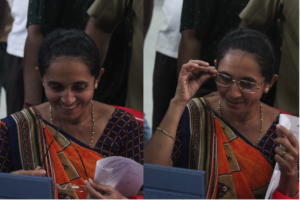Join a powerful, unprecedented alliance for better eye health for all.
Join IAPB-
Choose an alternate language here
Sanitation workers (SW) are individuals who are responsible for cleaning and maintaining public and private spaces to ensure cleanliness and hygiene. They play a crucial role in preventing the spread of diseases and maintaining a healthy environment. Prolonged exposure to elements and various harmful agents put SW at risk of many ocular morbidities, and yet, very little is known on the subject.[1] In appreciation for their relentless and admirable efforts throughout the most challenging times of the COVID-19 pandemic, Mission for Vision (MFV) and K.B. Haji Bachooali (KBHB) Eye Hospital co-implemented a series of eye health interventions in Mumbai city that included screening, awareness sessions, spectacle dispensing and referral for further treatment.

As part of this intervention, in the week leading to the World Sight Day – October 2022, and in conjecture with the theme “Love Your Eyes”, a comprehensive eye screening of 822 SW was undertaken and those diagnosed with refractive errors were provided spectacles at no cost. The median age was 45 years (Range: 18 – 58). Most (79.8%) were men and over three-quarters (76.8%) had secondary education. A total of 516 (62.8%) were identified with refractive errors (RE) and appropriate corrective spectacles were provided. A total of 742 (90.3%) had very good visual acuity in the better eye. A total of 34 (4.1%) were diagnosed with cataracts and two had squints. Depending upon the preliminary diagnosis, those suspected of any ocular anomaly were seen by an on-site ophthalmologist and a few were further referred to the partner hospital KBHB for further assessment and treatments. A total of 118 (14.4%) were referred to the base hospital for further evaluation and subsequent treatments, however, 17 (14.4%) turned up at the partnering base eye hospital in the months of October and November.
Enablers
For the smooth implementation of this eye health intervention, Mission for Vision joined hands with reputed tertiary-level eye hospital like KBHB eye hospital and received ample support from the government. Well-trained and qualified optometrists and ophthalmologists from MFV and KBHB equipped with the latest medical equipment, supported by a strong outreach team helped in providing comprehensive primary eye screening, diagnosis, and referral services. This unique model of co-implementation facilitated quality medical and clinical care, thereby improving the overall eye health of SWs and also helped managed the heavy footfall.
Future Enablers

Opportunities and the way forward
Facilitating mandatory annual eye examinations and screening for SWs by making crucial policy changes will help in screening and diagnosing any eye conditions and will go a long way in reducing the cases of avoidable blindness.
2. Scale-up and expand to wider geographies
There is a clear need to expand and scale-up this intervention to wider geographies. This can be achieved by conducting needs assessments, develop and forge new partnerships with diverse stakeholders, customise interventions as per local needs, leverage technology, mobilise sufficient resources, and conduct regular and periodic monitoring and evaluation of such interventions.
In conclusion, ensuring the eye health of SWs requires a multifaceted approach that addresses the unique challenges and risks associated with their work. By ensuring that all stakeholders work together to provide the necessary resources and support, eye care services can be delivered effectively and efficiently, thereby improving the overall eye health.
In addition, sensitisation meetings can be used as a platform to educate sanitation workers about the importance of regular eye exams, the risks associated with their job, and healthy eye care practices. This will ensure that the masses will proactively seek eye care and encourage them to adopt a health seeking behaviour.